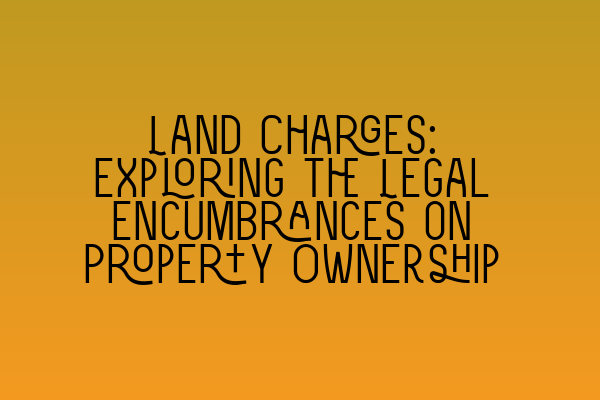Land Charges: Exploring the Legal Encumbrances on Property Ownership
When it comes to property ownership, there are several legal encumbrances that can affect the rights and obligations of the owner. These encumbrances are known as land charges and understanding their implications is crucial for both buyers and sellers in any property transaction.
What are land charges?
Land charges are legal interests or rights that are registered against a property. These charges can be created by various parties, such as lenders, creditors, or the government, and they can restrict or affect the owner’s ability to deal with the property.
There are two main types of land charges: registered and unregistered charges. Registered charges are those that have been officially recorded with the Land Registry, while unregistered charges have not been registered but still exist as legal interests.
Types of land charges
There are several types of land charges that can be placed on a property. Let’s explore some of the most common ones:
1. Mortgages
A mortgage is a loan secured against a property. When a property is mortgaged, the lender holds a legal charge over the property until the loan is fully repaid. This means that if the borrower fails to make repayments, the lender may have the right to repossess the property and sell it to recover the debt.
Want to learn more about mortgages? Check out this article on SQE Contract Law: Analyzing Landmark Cases and Influential Judicial Decisions.
2. Restrictive covenants
Restrictive covenants are legal obligations that are attached to a property and restrict its use in some way. These covenants are usually imposed by the original developer or owner of a property and can limit activities such as building extensions, keeping pets, or running a business from the property.
To dive deeper into restrictive covenants and their implications, take a look at this article on A Closer Look at SQE Contract Law Syllabus.
3. Easements
Easements are rights that allow someone else to use or access a portion of another person’s property. Common examples of easements include rights of way, where a neighbor has the right to walk across someone else’s land to access their own property, or the right to lay cables or pipes beneath the property.
If you’re interested in learning more about easements, check out this article on Contract Law for Services: Key Considerations and Best Practices.
Registering and removing land charges
In order to protect their interests, parties that hold land charges can register them with the Land Registry. This registration creates a public record of the charge, ensuring that anyone interested in the property can find out about the encumbrance before entering into a transaction.
Registering a land charge involves submitting the relevant documents and paying the required fees. Once registered, the charge will be recorded against the property’s title and will be disclosed in any searches carried out by potential buyers or lenders.
Removing a land charge can be more complex, as it requires the agreement of the party that holds the charge or a court order. However, once a charge is paid off or otherwise no longer applies, it is important to ensure that it is removed from the property’s record to prevent any potential issues in the future.
Conclusion
Land charges play a crucial role in property ownership, as they can affect the rights and obligations of owners. From mortgages to restrictive covenants and easements, it’s important for both buyers and sellers to understand and consider the implications of these encumbrances when entering into a property transaction.
For further reading on related topics, you may find these articles helpful:
- Ethics in Contract Law: Navigating the Moral and Legal Dimensions
- Misrepresentation in Contracts: Unveiling Deceptive Practices
- A Closer Look at SQE Contract Law Syllabus
- SQE Contract Law: Analyzing Landmark Cases and Influential Judicial Decisions
- Contract Law for Services: Key Considerations and Best Practices
